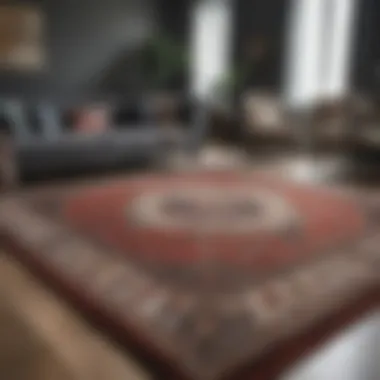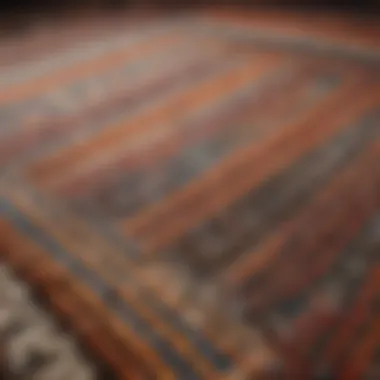Discovering the Art of Rugs: An In-Depth Guide


Intro
Rugs serve as more than mere coverings for floors; they are pivotal in setting the tone and atmosphere of a space. From contemporary settings that celebrate minimalism to traditional rooms that evoke nostalgia, rugs weave together various design elements, creating cohesion and warmth. This guide aims to unpack their multifaceted nature, pinpointing how they can transform living spaces and offering insights into their care, selection, and placement.
In a time where personal expression in home decor is paramount, understanding rugs becomes essential. Whether one favors bold patterns or understated elegance, or seeks functionality over flair, knowing the ins and outs of rugs enables homeowners, designers, and DIY lovers alike to make choices that best reflect their tastes and needs.
Furniture Styles and Trends
Integrating rugs into various furniture styles enhances the overall aesthetic of a room. Exploring the dialogue between furniture and rugs reveals not just visual harmony but also tactile experiences that can significantly improve a living space's comfort.
Modern vs. Traditional: Understanding the Key Differences
Modern design typically features clean lines, an emphasis on function, and an overall minimal aesthetic, while traditional styles often focus on ornate details, historical references, and rich fabrics. Rugs play a crucial role in bridging these two worlds, allowing for personal expression through careful selection and placement.
For instance, a low-pile rug with geometric patterns complements a modern sofa, striking the right balance without overwhelming the space. On the other hand, a richly textured Persian rug can infuse warmth and character into a traditional living room, grounding furniture while enhancing the layered look.
Top Furniture Trends to Watch in
As we venture deeper into 2023, several trends are reshaping the way we think about furniture and, in turn, rugs:
- Sustainable materials: An increasing demand for eco-friendly furniture leads consumers toward rugs made from natural fibers like jute and wool.
- Vintage revival: Retro-themed furnishings heighten the importance of vintage rugs, as they create a nostalgic appeal that speaks to many.
- Multifunctional pieces: With living spaces growing smaller, there's a push for furniture that offers dual purposes, often needing rugs that define areas within an open-concept layout.
These furniture trends are pivotal for those who want their spaces to coordinate seamlessly, and they highlight the need for thoughtful rug selection that complements evolving tastes.
Practical Tips for Furniture Selection
Selecting the right furniture is a process that demands consideration, and integrating rugs into the mix requires a similar level of discernment.
How to Choose the Right Furniture for Your Space
There are some core principles to consider:
- Evaluate the size of your room: Ensure that larger pieces do not overpower the space. Furniture should ideally correspond with the size and layout of the room.
- Think about the flow: Arrange furniture to facilitate movement. This means ensuring that rugs align in a way that does not disrupt traffic paths.
- Mix textures and patterns: Don’t shy away from combining materials. A hardwood floor paired with a richly textured rug can create a dynamic that is visually pleasing.
Sustainable Furniture: Tips for Eco-Friendly Choices
Environmentally conscious choices can also be woven into furniture selection:
- Look for certifications: Choose furniture and rugs that boast sustainability certifications.
- Opt for local artisans: Supporting local craftspeople reduces transportation emissions and is often a great way to find unique pieces.
- Incorporate recycled materials: Many eco-friendly furniture lines now feature pieces that utilize recycled resources, making sustainability stylish.
In a time when mindful living is pivotal, understanding how to choose the right furnishings — including rugs — can not only embellish your home but also promote sustainability.
Overall, the interplay between rugs and furniture styles manifests a deeper conversation about what we choose to bring into our spaces. By enhancing understanding around these elements, readers can cultivate environments that reflect their own tastes and values.
Significance of Rugs in Interior Design
Rugs are more than mere floor coverings; they play a vital role in shaping the character and ambiance of any space. As individuals curate their homes, the choice of a rug can bridge the gap between various design elements, creating harmony while serving distinct functions. Understanding the significance of rugs in interior design leads to more informed and intentional choices, ensuring that every room reflects both style and purpose.
Aesthetic Enhancements
A well-chosen rug injects instant flair into a room. Think of it as the pièce de résistance of your interior. It draws the eye and anchors the space, setting a tone that can be welcoming or dramatic. The colors, patterns, and textures can add depth and dimension, breaking the monotony of hardwood or tile floors. A bold geometric pattern in a modern living room can pop against minimalist furniture, while a vintage Persian rug can weave warmth into a more traditional setting. Notably, a rug serves as a canvas for other decor. When combined with complementary hues found in throw pillows or artwork, it ties everything together like a neat bow.
Functional Benefits
Beyond beauty, rugs have practical applications as well. They enhance comfort, providing a cushioned surface underfoot, which is especially appreciated in high-traffic areas like living rooms and kitchens. They also dampen sounds. Imagine living in a bustling city, where the echoes of footsteps or sounds of a busy street come seeping in; a thick rug can absorb those noises and create a more peaceful home environment.
Additionally, rugs play a role in defining spaces within larger areas. In open-concept homes, for example, a strategically placed rug can delineate the living room from the dining area, guiding the flow of movement and interaction.
Rugs as Cultural Symbols
Rugs carry historical and cultural significance that can enrich your space in unexpected ways. For many cultures, rugs are crafted with intricate patterns that tell stories or celebrate identity. Consider Scandinavian rugs; with their simple lines and natural materials, they evoke a sense of coziness that reflects the lifestyle of Nordic countries.
On another hand, a vibrant kilim rug introduces a splash of color and celebrates the craftsmanship of its origins. Investing in such rugs can be akin to collecting art; each one has a unique narrative that enhances the overall character of your home.
"Rugs are like the heartbeat of a room; they energize and sustain the atmosphere, making spaces feel lived-in and loved."
Types of Rugs Available


Rugs come in a myriad of styles, materials, and designs, reflecting the diverse taste of homeowners and designers. The choice of the right rug can significantly impacting a room's ambiance, aesthetics, and comfort. Understanding the types of rugs available is crucial when selecting the perfect piece to enhance any space. Here, we'll break down some fundamental categories, ensuring you know the ins and outs before making a decision.
Handmade vs. Machine-Made
When it comes to rugs, the distinction between handmade and machine-made can be more than just a matter of craftsmanship. Handmade rugs often showcase intricate designs and unique patterns, resulting from skilled artisans pouring countless hours into each creation. This means each piece carries a story, often linked to cultural heritage.
On the flip side, machine-made rugs offer consistency and affordability. While they might lack the personal touch and uniqueness of handmade counterparts, they can still provide quality and style for budget-conscious buyers. Think about your needs—do you prefer the charm of a handmade piece, or are you looking for something practical that is easy to maintain?
Natural Fiber Rugs
Natural fiber rugs are crafted from materials like jute, sisal, or wool and have gained traction in recent years. These rugs are celebrated for their eco-friendliness and durability. Jute rugs, for example, introduce a warm, earthy feel into any space and are great for high-traffic areas. Wool, known for its softness, is often used in living rooms and bedrooms for comfort underfoot.
One important thing to keep in mind is that natural fibers can be sensitive to moisture. Spills may require immediate attention to prevent damage. Nevertheless, their aesthetics and sustainability make them an excellent choice for the environmentally-conscious consumer.
Synthetic Rugs
Synthetic rugs, made from materials such as polyester or nylon, are perfect if you’re after function without sacrificing style. They’re typically more stain-resistant than their natural counterparts, making them ideal for homes with young children or pets. These rugs are easy to clean and often cheaper than natural fiber options.
However, some may argue that they lack the warmth and texture of natural fibers. It's essential to evaluate your lifestyle needs against these materials' characteristics. Would you prefer easy maintenance, or are you drawn to the authenticity of natural fibers?
Persian and Oriental Rugs
Often regarded as the epitome of luxury in rug design, Persian and Oriental rugs are beloved for their ornate patterns and deep colors. These rugs often feature traditional motifs that tell stories of ancient cultures, making them not only decor items but also pieces of art.
Investing in one of these rugs can elevate your space, providing a touch of elegance and timelessness. Beyond aesthetics, they also come with significant price tags—it's important to ensure authenticity through documentation or reputable sellers, as there are plenty of reproductions in the market.
Contemporary and Modern Rugs
For those who lean toward a more minimalist or trend-driven aesthetic, contemporary and modern rugs offer a wealth of opportunities to express creativity. These rugs often feature bold colors, geometric shapes, or abstract designs. They not only complement but can also be seen as statement pieces that complete a room's look.
While selecting a contemporary rug, consider its role in your space. Will it provide a contrast to existing decor, or will it tie together an otherwise disparate color scheme? Getting the most out of a modern rug involves careful consideration of where and how it will be displayed.
"Understanding the types of rugs available is fundamental for anyone looking to enhance their living spaces. Each type has its own distinct characteristics and benefits, allowing for a tailored fit depending on personal style and practical needs."
Armed with this knowledge about different types of rugs, homeowners and designers alike can make informed choices that align with their vision for a space.
Choosing the Right Rug for Your Space
Selecting the right rug for any room can often feel like trying to solve a complex puzzle. It’s a critical aspect of interior design that shouldn’t be overlooked. A rug’s presence can anchor a space, draw attention to furniture, or simply add a burst of color. The stakes are, indeed, high—getting it right enhances style while getting it wrong can throw the whole look off balance.
Sizing Considerations
When it comes to choosing a rug, size does matter, possibly more than anything else. An oversized rug can swallow a room, while a too-small one can feel like it’s lost in space. Here are some sizing considerations to keep in mind:
- Room Dimensions: Measure the area where the rug will go. Consider the space you want the rug to occupy—whether you want it under furniture or just beside it.
- Placement in the Room: In living rooms, it's best to have the front legs of seating furniture on the rug, creating a cohesive look. In a dining area, aim for a rug large enough to accommodate the table and chairs, even when they are pulled out.
- Traffic Flow: Think about how people will move around the room. A larger rug can help define areas while a smaller one might restrict movement.
By keeping these factors in mind, you can avoid the all-too-common mistake of choosing a rug that simply isn't proportionate in your discourse of home aesthetics.
Color Coordination
Colors set the mood for any room. When choosing a rug, think about how its hues will play with the existing palette in the space. Here are some essential points:
- With Existing Colors: Pull from other elements in the room—sofa, curtains, artworks—and see how your potential rug can complement or provide contrast. For instance, if your space is neutral, a colorful rug can elevate the vibe.
- Creating Flow: Consider rugs as part of a broader theme. If you've got a modern decor, a geometric pattern or sleek hues may work best; traditional styles might call for more intricate designs.
- Accent Colors: Using a rug to introduce a splash of color can provide warmth. Opt for shades that evoke feelings you wish to foster in that space, such as calmness or vibrancy.
This aspect is akin to painting—it takes a little intuition and a keen eye to hit the right balance.
Styling Tips for Integration
Once you’ve nailed down size and color, it’s time to think about how to integrate the rug seamlessly into your decor. Here are some tips to finesse that:
- Layering: If you already have a rug, layering another smaller rug on top can create depth. Just ensure they complement each other. Think of your rug as an outfit; mixing patterns can create a unique fashion statement.
- Use Furniture to Frame: Arrange furniture to frame the rug. By creating a unified space, it not only looks better but feels more inviting. A common approach is to position furniture at angles instead of lines, enhancing visual interest.
- Accessorizing Around the Rug: Adding accents like coffee tables or artwork can help create a focal point around the rug. This brings attention without overwhelming the space.
By cleverly considering these elements, a rug can drape a room in a harmonic embrace, linking all the pieces together.
"A well-chosen rug does more than warm your feet; it warms your soul by binding the elements of a room."
Rug Placement Techniques
The art of arranging rugs isn't just about aesthetics; it’s about creating an atmosphere. The proper placement of rugs can significantly influence the flow and functionality of a space. Whether you're looking to define areas within an open floor plan or simply want to add warmth to a room, understanding rug placement techniques is crucial. This section delves into different setups applicable to various rooms, focusing on living rooms, bedrooms, and dining areas.


Living Room Setups
Living rooms are often the heart of a home, a space meant for relaxation and socialization. The placement of a rug in this area can help delineate different zones, giving character and structure to the overall aesthetic. Here are a few techniques to consider:
- Full Coverage: A large rug can anchor furniture, making the space feel cohesive. Ensure the front legs of sofas and chairs sit on the rug. This approach is fantastic for creating a unified look.
- Partial Placement: If you have a smaller room, you can opt for a rug that sits entirely under the coffee table, with only the rear legs of the sofas on the rug. This style retains openness while still providing a cozy element to the room.
- Layering: For an eclectic or bohemian vibe, layering rugs can be effective. Combining a larger, neutral rug with a smaller, patterned one adds depth and interest. Just be cautious not to overwhelm the space.
Bedroom Arrangements
In bedrooms, rugs play a dual role of adding comfort and enhancing décor. When it comes to arranging rugs, keep these considerations in mind:
- Bed Placement: Position a rug under the bed, extending it on both sides for that warm, welcoming feel when you step out of bed. A rug that extends at least 18 to 24 inches beyond the edges of the bed works wonders.
- Area Rugs: If space allows, you can use two smaller rugs on either side of the bed instead of one larger rug. This scenario is especially useful in tighter spaces or can even be a stylish choice for two twin beds.
- Balance with Other Elements: Ensure the rug complements other décor aspects, like curtains and bedding colors. A well-chosen rug can tie the room together.
Dining Area Configurations
The dining area holds its unique challenges regarding rug placement. A thoughtfully chosen rug can add a touch of elegance, but it must also be practical. Here are some tips:
- Size Matters: Ideally, your rug should be large enough for all chair legs to remain on it, even when pulled out. This protects your floor and adds to the visual harmony of your setup.
- Shape and Material: Round tables often look best on round or oval rugs, while rectangular tables pair nicely with long rectangular rugs. Choosing the right material is equally important, especially for spills, so consider options like indoor-outdoor rugs that are durable yet stylish.
- Separation from Other Spaces: If your dining area is part of an open floor plan, a rug can visually separate it from the living area. Ensure the rug's design complements the surrounding colors and textures for a fluid transition.
"Placement is not merely a design choice; it's how we communicate the function and feel of a space."
By understanding these distinct rug placement techniques, you'll be well on your way to creating inviting, functional spaces. Getting the right placement can transform an ordinary area into something quite special.
Caring for and Maintaining Rugs
Rugs can make a room feel cozy and complete, but their beauty comes with the responsibility of proper care and maintenance. Understanding how to keep your rugs in top shape goes beyond just aesthetics. It is essential for preserving their lifespan and ensuring they endure the daily wear and tear of a bustling home. The right upkeep not only enhances the aesthetic appeal but also contributes to a healthier living environment by reducing allergens and dust accumulation.
Cleaning Techniques
Regular cleaning is the backbone of rug maintenance. Different cleaning techniques are suited to different materials and fibers. Vacuuming is an absolute must; it’s like brushing your hair. Aim for at least once a week—this helps remove dirt before it settles into the fibers. For high-pile rugs or those made of delicate materials, using a vacuum with a gentle brush is recommended to avoid damage.
It may also benefit your rugs to give them a deep clean occasionally. This can mean professional cleaning or tackling spots with homemade solutions. A mixture of water and white vinegar is often effective. Just make sure to do a patch test first—nobody wants to accidentally bleach their favorite piece!
Dealing with Stains and Spills
Spills can happen in a blink of an eye, but how you react makes all the difference. The key is to act fast. Blot, don’t rub. Use a clean cloth to soak up the liquid, and always work from the outside of the stain to the center. Rubbing might just spread it further, and you’ll end up with a larger headache.
When it comes to stubborn stains, every material has its own quirks. For instance, for wool rugs, combining a little dish soap with water can do wonders. If you face a grease stain, cornstarch can work magic by soaking up the oil. Keep a few common household items on hand that can help tackle unexpected messes.
Regular Maintenance Practices
Aside from cleaning and addressing spills, establishing a regular maintenance routine can extend the life of your rugs significantly. Rotate your rugs every few months. Sunlight can fade colors over time; flipping the rug ensures even wear across the fibers.
Additionally, consider using a rug pad. Not only do they prevent slipping, but they also absorb impact, protecting your rug’s foundation from the hard floor underneath.
"Proper care creates longevity—like tending a garden, the more you nurture, the more it flourishes."
In a nutshell, maintaining your rugs is about being proactive rather than reactive. Simple routines and prompt actions have lasting effects that allow your rugs to continue bringing warmth and style to your spaces.
Sustainable Options in Rug Selection
In today's world, where climate change and responsible consumption take center stage, the topic of sustainable options in rug selection becomes not just relevant but crucial. Rugs can serve as focal points in homes, but the materials and processes used in their production can leave a significant footprint on the environment. Thus, choosing sustainable rugs not only enhances your living space but also contributes to a healthier planet. Understanding different eco-friendly choices—alongside their impacts—can guide homeowners, designers, and DIY enthusiasts to make informed decisions.
Eco-Friendly Materials
When it comes to rug selection, the materials used can dictate their environmental impact. Not all fibers are created equal in terms of sustainability. Natural fibers like jute, sisal, and hemp stand out among their synthetic counterparts. These materials are not only biodegradable but also require fewer synthetic resources to produce.
For example, jute is exceptionally versatile and often grown in regions devoid of chemical fertilizers or pesticides, making it a low-impact choice. It’s like Mother Nature’s own little gift, providing a durable rug that lasts years while being easy on the environment. Wool is another natural option worth noting; it is renewable, biodegradable, and has natural fire-retardant properties.
By selecting rugs made from these materials, you help reduce reliance on petroleum-based products. That’s a win-win! Also, consider looking for rugs dyed with low-impact or natural dyes to further enhance sustainability.
Supporting Ethical Production
Beyond materials, ethical production practices play an essential role in sustainable rug selection. Supporting companies that prioritize fair labor practices ensures that workers are treated with respect and compensated fairly. When shopping for rugs, look for brands that are transparent about their production processes. A responsible producer might share details such as their supply chain sourcing and working conditions, which can reflect their commitment to ethical practices.
Moreover, some manufacturers engage in community-based production models, empowering local artisans and keeping traditional craftsmanship alive. Choosing rugs from such sources fosters economic development in communities while honoring age-old techniques. As they say, you’re not just buying a rug; you’re investing in a story, a culture, and a better tomorrow.
"Responsible choices in rug selection create a ripple effect, influencing buyers, producers, and entire communities toward a more sustainable future."


In essence, integrating sustainable options into your rug selection process can transform a simple home decor choice into a more significant statement of values. It presents an opportunity to balance aesthetics with responsibility, ensuring that both your space and the planet thrive. Engaging in this mindful approach means you curate not just your home, but also a legacy of sustainability.
Trends in Rug Design
The landscape of rug design is ever-evolving, driven by a confluence of cultural shifts, technological advancements, and individual preferences. Understanding current trends in rug design not only informs homeowners and designers but also enhances the overall aesthetic and functionality of living spaces. From organic materials to bold designs, these trends reflect broader design movements and address the growing emphasis on sustainability and personalization.
This section delves into two pivotal aspects of modern rug design: the popular patterns and textures that are making waves in homes today and the color palettes in fashion that underscore contemporary styles.
Popular Patterns and Textures
Rug patterns and textures have a profound effect on how a room is perceived. Presently, geometric shapes and abstract designs are dominating the scene, offering homeowners a chance to make bold statements with their floor coverings. Rather than opting for subdued and uniform looks, many are gravitating toward dynamic patterns that add visual intrigue. Consider the following:
- Layering Textures: Combining different materials like wool, jute, and synthetic fibers creates depth in a space. Textured rugs can transform an ordinary room into a warm haven.
- Natural Patterns: Incorporating motifs inspired by nature, such as leaf prints or animal motifs, connects interior environments to the outdoors while keeping things fresh and inviting.
- Handcrafted Appeal: Hand-knotted or tufted rugs with intricate designs evoke a sense of authenticity and craftsmanship. The unique imperfections found in handmade pieces often draw admirers and create conversation starters.
"A statement rug can redefine a living area, serving as both art and functionality. Look for designs that resonate with your style and create an emotional connection.”
This resurgence of eye-catching patterns reflects a shift towards personalization in design. Homeowners are increasingly willing to experiment, making choices that align with their individual tastes. After all, the right rug can unify a room, pulling together furniture and decor into a seamless composition.
Color Palettes in Fashion
In the realm of interior design, color is not just decoration; it's a language of its own. The prevailing color trends in rugs are moving toward vibrant hues and sophisticated neutrals, allowing flexibility in design choices.
- Bold and Bright: From deep blues to vivid reds, these bold colors are making waves. Such rugs can serve as focal points in minimalist spaces or complement existing vibrant decor.
- Earthy Tones: Shades like terracotta, olive green, and cream offer soothing qualities, grounding a room and creating warmth. They work especially well in rustic or organic-themed interiors.
- Monochromatic Schemes: Many are opting for rugs in varying shades of a single color, creating a chic and cohesive look. Delicate variations in hue offer subtlety, yet maintain interest through texture and material.
Additionally, the influence of cultural palettes can't go unnoticed. As homeowners become more globally minded, designs that incorporate traditional colors from various cultures are gaining traction, reflecting the multicultural ethos of modern living.
Understanding these color palettes enables homeowners and designers to make informed decisions that align with the intended atmosphere of their spaces. By weaving the right colors into a room, one can achieve an atmosphere that reflects both comfort and style.
Mistakes to Avoid When Buying Rugs
When folks set out to buy rugs, it can become quite the task. There's a world of options, and navigating this terrain isn’t as straightforward as it might seem. Avoiding pitfalls in the selection process hinges not just on aesthetics but also on practical considerations. A misstep can lead to a mismatched decor or a purchase that's regretted sooner rather than later. Here, we’ll discuss some of the common oversights buyers make, especially those who may not be familiar with rugs.
Common Pitfalls in Selection
One of the first misjudgments many individuals encounter lies in the realm of sizing. You might be frowning at a stunning rug only to find it fits the space awkwardly—too small and it gets lost, too large and it overwhelms the room. It's critical to measure your space beforehand. As a rule of thumb, many designers advocate for leaving at least 18 inches of floor space around the rug to create a flowing, cohesive look.
Another often overlooked aspect is consideration of the environment the rug will inhabit. Whether it's a high-traffic area like the living room or a quieter space such as a bedroom, thinking about the durability and maintenance needs of the rug is vital. For instance, a plush, delicate rug might be a mishap in a bustling hallway; instead, a flatweave or synthetic material could offer more resilience.
Additionally, matching the rug pattern with your existing décor style can feel like walking a tightrope. You don’t want a rug to clash glaringly with your furniture; ideally, it should compliment and unify your design vision. Engaging with a design professional or utilizing online visualizers can be an invaluable aid.
Ignoring Quality Factors
Quality often takes a back seat when buyers focus solely on price. Many people think they can score a deal without realizing that the craftsmanship of a rug significantly influences its longevity. Consider investing in a well-crafted piece, especially if you plan to keep the rug for a long while. Handmade rugs, for instance, typically feature stronger, more durable fibers than their machine-made counterparts.
Moreover, inspecting the material is essential. Natural fibers like wool and cotton offer various benefits, from softness to durability. On the other hand, synthetic fibers may present a lower upfront cost but can affect comfort and longevity. When checking out rugs in stores, run your hand across the surface; it should feel pleasant without excessive shedding—this can be a signal of inferior quality.
Finally, get familiar with the care requirements of the rugs you're eyeing. Ignoring maintenance guidelines can lead to early wear and disappointment. Some rugs may need professional cleaning or specific maintenance techniques that can add to the overall cost over time. A few extra minutes spent understanding these quality factors can save you from headaches down the line.
"A rug, though often just realized as decor, plays a significant role in defining the atmosphere of a space. Getting it right on the first try is half the story."
Resources and Where to Buy Rugs
Understanding the landscape of resources for purchasing rugs is crucial for anyone looking to enhance their interiors. The choices available can be overwhelming, yet being well-informed can make all the difference in finding the right fit for your space. Rug shopping is not just about aesthetics; it reflects a personal style and intent. Therefore, knowing where to look for these pieces can save time, ensure quality, and help uncover unique finds that can transform a room.
When considering where to buy rugs, it’s essential to weigh the benefits of both local retail options and online marketplaces. Each has its distinct advantages, catering to varied preferences and needs. Here’s what stands out in each category:
Local Retail Options
Visiting local stores can offer a tactile experience that online shopping cannot replicate. It allows you to see, feel, and assess the quality of the rugs in person.
- Personal Touch: Engaging with shop owners or employees can lead to personalized recommendations based on specific requirements.
- Immediate Gratification: Instead of waiting for shipping, you can take your choice home right away.
- Community Support: Choosing local options helps support small businesses and the local economy.
Popular local places to find rugs often include family-owned shops, thrift stores, and specialized home goods stores. For instance, shops might carry traditional handwoven options or unique pieces sourced from various cultures. This means you might find something not typically available in chain stores.
Online Marketplaces
The digital realm opens up a world of options that can often seem endless. Shopping online provides the convenience of browsing various styles, sizes, and prices all from your living room.
- Extensive Selection: Websites like Wayfair, Amazon, and Etsy boast vast inventories, featuring everything from bohemian styles to modern designs.
- Price Comparisons: It’s easier to compare prices and check reviews, ensuring competitive pricing and feedback from other customers.
- Luxury Brands at Hand: Many high-end retailers offer e-commerce platforms, giving access to luxurious carpets without needing to travel to showrooms.
However, online shopping does come with its caveats. Ensure you check return policies and read reviews carefully to avoid the pitfalls often associated with buying unseen products. It’s wise to consider sites that encourage customer feedback, enabling insights on durability and comfort.
A well-chosen rug not only unifies a room but also provides comfort underfoot, making the selection process worth the time and effort.
Both local and online resources play a significant role in acquiring rugs that resonate with your personal style. By understanding the pros and cons of each option, you can make an informed decision that suits your taste and requirements, enhancing your home’s overall aesthetic.







